Clean your clothes and conserve energy with one of these outstanding washers.
BobVila.com and its partners may earn a commission if you purchase a product through one of our links.
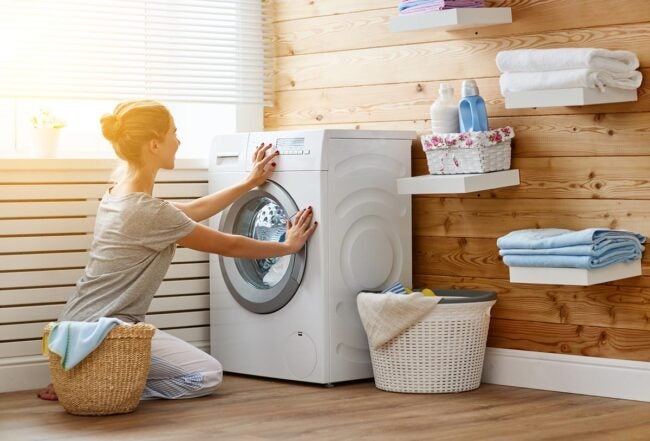
Photo: depositphotos.com
A quality washing machine should last at least 10 years, but many things happen to a brand’s technology over the course of a decade, which can make choosing a new one challenging. In addition to ample power and excellent cleaning ability, the best modern washing machine models offer an array of other features. There are machines designed to use water and energy more efficiently, ones with a wide range of functionality for different fabrics and soils, and some even offer smart technology. Ahead, you’ll find the important considerations to bear in mind while shopping for a new washer, and why these picks rate as some of the best in their class.
- BEST FRONT-LOADING: LG 4.5 Cu. Ft. 14-Cycle Front-Loading Washer
- BEST TOP-LOADING: GE 4.8-cu ft High Efficiency Top-Load Washer
- BEST BANG FOR THE BUCK: Amana 3.5-cu ft Top-Load Washer
- UPGRADE PICK: GE 5.0 cu. ft. Front Load Washing Machine
- BEST FOR LARGE LOADS: GE 4.8 Cu. Ft. High-Efficiency Front-Loading Washer
- ENERGY-EFFICIENT PICK: Electrolux 4.4 cu. ft. Front Load Washer
- STACKABLE PICK: Maytag 4.8 cu. ft. Front Load Washing Machine
- SMART PICK: Whirlpool 5.0 cu. ft. Front Load Washing Machine
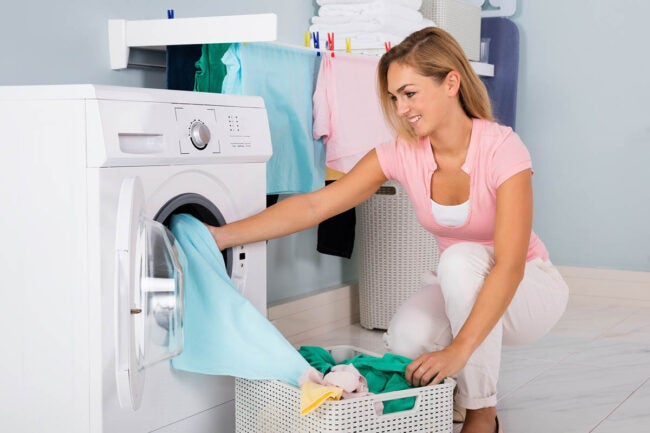
Photo: depositphotos.com
Types of Washing Machines
Washing machines come in two basic forms, front-loading and top-loading. Top-loading washers were the standard for decades, and still hold a strong place. Old-fashioned front-loaders had a reputation for maintenance problems and mildew growth, but the new crop has largely outsmarted these issues while packing in plenty of helpful technology.
Front-Loading Washer
Front-loaders clean more thoroughly and efficiently, using less water and electricity than top-loaders. Plus, front-loading washers remove more water at the end of the cycle. And if the units stack, they save space.
Unlike the twisting action of top-loading machines, front-loaders use a tumbling motion to clean laundry. No space is lost to the agitator, the vertical center arm that provides motion in many top-loading washers, so the whole interior is available for laundry. The tumbling action is more gentle on clothing than an agitator, which can pull, twist, and snag. They also require about five fewer gallons of water per load, which adds up to about 2,000 gallons per year.
While the machine itself is more energy-efficient, it also saves energy that other appliances use. A reduced wash water requirement translates to a reduction in hot water usage, so the water heater isn’t working as much. Also, because the washer removes more water from the clothes at the end of the cycle, the dryer doesn’t run as long.
On the downside, front-loaders are not as durable as top-loaders. Overloading the machine can wear out the rear bearing—the part that supports the weight and movement of the drum—which will mean a pricey repair bill. They require more maintenance, such as cleaning the door and gasket after every use, to ensure that mold and mildew don’t build up inside the drum or on the door. What’s more, anyone with back problems may find bending over to load and unload the washer uncomfortable.
Top-Loading Washer
Most folks find top-loading washers clean adequately and are pleased to avoid some of the maintenance issues associated with front-loaders. In some situations, opening the lid on a top-loading washing machine can be a smarter use of space than swinging the front door of a front-loader. Also, they may be less of a back strain for some users.
High-efficiency machines, which use multidirectional wash tub movement instead of an agitator, are the best bet for cleaning ability and water usage in the top-loading category. The wash-cycle runs longer, but the energy and water savings are significant. By pre-treating stains, top-loaders can produce similar cleaning results as front-loaders but cost less.
What to Consider When Buying a Washing Machine
The perfect washer will fit its allotted spot, hold lots of dirty laundry, and have plenty of cleaning options for different fabrics and soils. Here’s what to factor into your search for the best washing machine for your space, stuff, and lifestyle.
Size
While shopping for a washer, consider the dimensions of the laundry room or other space available for the machine. For a side-by-side washer and dryer setup, the minimum space requirement is 54 inches wide. Standard height ranges from 38 to 43 inches, and depths between 28 to 34 inches.
Compact washers measure about 24 inches wide, while standard machines are 26 inches or larger. If space is limited, a compact washing machine may be the best choice. Compact washers are about the size of a dishwasher and fit within different cabinet configurations.
Capacity
Washer capacity refers to the internal volume of the drum. The size determines the amount of laundry that can wash per load. For one or two people, a small- to medium-sized washer with a capacity of 1.8 to 3.5 cubic feet is ideal. Families need the larger 3.6 to 5.1 cubic foot capacity of a large washing machine.
The washing machines with the highest capacity are front-loaders, mostly between 4.2 and 4.5 cubic feet. Some go as high as 5.0 cubic feet. Top-loaders range from 3.1 to 4.0 cubic feet. Compact washing machines have a capacity of just over 1.5 cubic feet.
Configuration
Washer/dryer combinations can be configured either side-by-side or stacked. In stacked combos, the heavier washer supports the dryer. Stacked units save floor space, but require bending and reaching to access the front loading machines. Also, the swinging front doors don’t work with every floor plan.
Side-by-side washers and dryers offer the flexibility to use either front-loading or top-loading washing machines. In this configuration, front-loading washers can be placed on a pedestal for easier access without bending.
Options for Cycles
The basic washing machine cycle is wash-soak-rinse-spin, but plenty of other options are available. Older machines used mechanical controls to select for water temperature, water level, wash action, and run time. Most current models use electronic programs that conserve water and energy while providing a better quality wash. The following are the cycles to look for in your next washer.
- Normal Wash: This is the go-to setting for normally soiled cotton and linen fabrics like mixed garments and sheets. It uses warm water and a high spin rate for maximum efficiency.
- Cold Water Wash: Cold water is the key to avoiding fading in dark-colored clothing, and retaining the brightness of bright colored linens, casual clothes, and mixed loads. It is also the choice for lifting cold water stains like blood and toothpaste. It uses additional wash action with a cold water wash and rinse. Some washers feature separate cycles for “colors” and “darks” that may have subtle differences.
- Whites: The “white fabrics” cycle uses hot water and automatically dispenses chlorine bleach at the right time.
- Heavy-Duty: Sturdy, colorfast items like jeans and towels sometimes need intense cleaning. The “heavy-duty” cycle uses extra wash action and hot water to aggressively break down dirt. Some machines also have a “towels” cycle.
- Wrinkle Control: Choose this cycle to wash button-down shirts, professional clothing, linens, synthetic blend activewear and non-iron clothing, and any garment with “permanent press” on the tag. These cycles use a low-speed wash and medium spin rate and warm water. Also called “permanent press” and “casuals.”
- Delicate: The delicate cycle combines gentle wash action with a low spin rate in cold water. Use it for lightly-soiled sweaters, wool, delicates, machine washable lace and silk, and anything with “gentle” on the tag. It may also be listed as the “gentle” or “hand wash” cycle.
- Bulky: Use this setting for coats and jackets, bedding, and small rugs. It is a warm water cycle that uses a modified washing action to reduce tangling. The “bulky” cycle may also be called the “bedding” or “sheets” cycle.
- Rinse and Spin: Use this quick, cold water cycle for items that need a rinse without detergent, such as swimsuits, or as an add-on for items that may need an additional rinse.
- Sanitize: This is a hot or extra hot water cycle for items that need to be sanitized. It may require a special detergent for full effect.
- Deep Water Wash: Some washers offer this cycle for heavily-soiled casual and mixed loads. It uses additional water and robust washing action in warm water.
Water and Energy Efficiency
While part of a washing machine’s cost is the upfront price, a much larger aspect is the operating expense. Using 40 gallons or more of water per load, a washing machine quickly adds to the monthly water bill. Much of that water must be heated first, increasing the gas or electricity bill as well. To greatly reduce the overall cost of owning a washer, look for a water- and energy-efficient model.
Older washing machines used between 30 and 45 gallons of water per load. Modern high-efficiency washers only use from 15 to 30 gallons to wash the same amount of laundry. The high-efficiency benchmark is now 5 gallons per cubic foot of capacity. A highly-efficient 3.5 cubic foot washer uses about 17.5 gallons of water per load.
To make it simple, look for the U.S. Environmental Protection Agency’s (EPA) Energy Star insignia. Energy Star qualified appliances are proven to operate 10 to 20 percent more efficiently than their non-Energy Star peers. Additionally, the Consortium for Energy Efficiency’s (CEE) Super Efficient Home Appliance Initiative provides tiered ratings. Tier I is approximately equivalent to Energy Star qualification. Washing machines with higher tier ratings, up to Tier 4, show increasing levels of efficiency.
Other Conveniences
The newest washing machines offer loads of technological conveniences to make laundry day easier. Look for upgrades such as:
- Reversible door for convenient setup on either side of the dryer
- Speed wash cycle
- Automated water level
- Scheduled cycle start
- Interior light
- Ventilation system and maintenance cycle to keep the machine clean and fresh
- Wifi connection and app for remote operation
- Compatibility with smart home devices like Amazon Alexa and Google Assistant
- Automatic detergent dispenser
- Fresh hold laundry ventilation system that ventilates clean laundry while in the drum, keeping it fresh until it’s unloaded.
- Dryer capability that allows the washer to double as a dryer (for small loads)
Our Top Picks
The washing machines showcased here reflect some of the best available, based on the shopping considerations outlined above.
Best Front-Loading
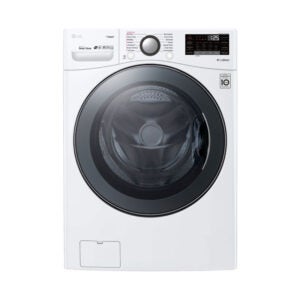
If you want quiet and convenience in your washing machine, the LG 4.5 Cu. Ft. 14-Cycle Front-Loading Washer is a worthy option, offering superior washing capability without added noise. Fill with detergent once a month and allow the easy dispense system to dispense the right amount for each load. Unique wash technology moves the load in six different directions for an aggressive cleaning cycle that is safe for delicates. An updated balancing system ensures that the machine operates quietly and efficiently.
This machine is wifi capable and works with both Amazon Alexa and Google Assistant. Should a problem arise, remote assistance and diagnosis are available through the app. A monthly tub clean cycle keeps the machine smelling clean and fresh. Some reviewers struggled with too many options or didn’t like the app, but customer support has proven helpful when needed.
Best Top-Loading
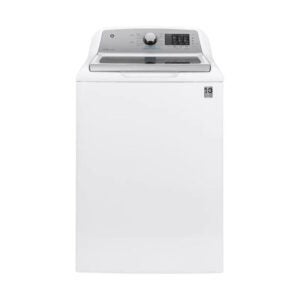
For those more comfortable with a top-loader, the GE 4.8-cu. ft. High Efficiency Top-Load Washer is one of the best in its category. Its FlexDispense detergent system automatically releases liquid, powder, or pods at the right time for faster activation and optimal wash performance. Dynamic balancing ensures a quiet wash and less vibration.
The system offers pre-programmed wash settings, or you can customize your own. A deep fill option allows you to fill the tub with the amount of water you choose. Choose from rinse options for detergent, fabric softeners, and hard-to-remove soils by selecting deep rinse, extra rinse, or warm rinse. A sanitizing wash cycle uses an Oxi additive to boost the cleaning power of your detergent and remove 99.9 percent of bacteria. If you’re in a hurry, use the speed wash cycle.
This high-efficiency washer uses very little water, compared with older machines—perhaps one reason some reviewers used the deep water option more often than they expected. Although washing is quiet, the spin cycle is a bit louder.
Best Bang for the Buck
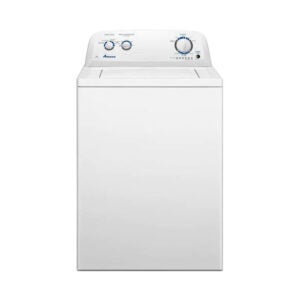
Many shoppers are satisfied with a basic, effective, and budget-friendly washing machine—the Amana 3.5 cu. ft. Top-Load Washer fits the bill. Choose from either the automatic water level sensor setting or deep water setting, with or without an extra rinse, and five water temperature settings. Basic wash cycles include normal, bulk, and delicate cycles. The dual-action agitator cycles the laundry to the bottom of the washtub for a thorough cleaning.
No bells or whistles here, and the price is half compared to premium models. For a dependable machine at an affordable price, the Amana is a solid machine.
Upgrade Pick
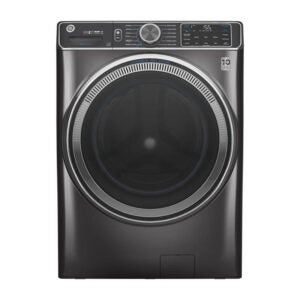
The GE 5.0 cu. ft. Front Load Washing Machine includes a reversible door, for placement on either side of the dryer. It is wifi-enabled so you can start, stop, or check the status from anywhere. Use the smart dispense detergent system to automatically apply the right amount of detergent at the right time. An onboard water heater increases the heat of hot water for added cleaning power. Use the sanitizing/allergen cycle to kill 99.9 percent of household bacteria and allergens.
This washing machine also includes a 37-minute time saver cycle that washes any size load fast or a 20-minute quick wash for small loads. Keep laundry day moving with the one-step wash-plus-dry feature that allows the washer to function as a dryer—a convenience best for overnight or during a workday.
Best for Large Loads
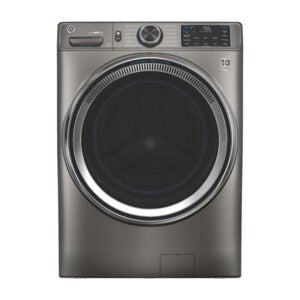
The GE 4.8 cu. ft. High-Efficiency Front-Loading Washer is large enough to hold comforters, sleeping bags, or the whole family’s dirty clothes. It uses dynamic balancing technology to rebalance loads for better washing and increased stability. A power steam cycle helps lift heavy stains, and there are dozens of options to customize and personalized wash cycle settings can be saved in the system for future use. The smart dispense detergent system washes up to 32 loads before needing to be refilled.
This machine is Energy Star and CEE Tier I rated. It is wifi-enabled and works with Amazon Alexa and Google Assistant—use the app to keep track of your laundry from anywhere. Bonus features include a reversible door, a 20-minute quick wash cycle, a sanitize cycle, and an ultra-fresh vent system to eliminate excess moisture from the machine after use.
Energy-Efficient Pick
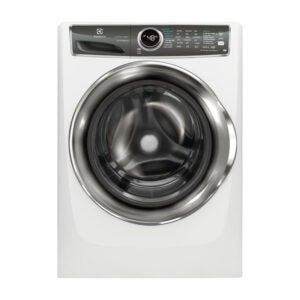
Save water and energy with the Electrolux 4.4 cu. ft. Front Load Washer, which is a competent washer rated Energy Star Most Efficient and CEE Tier III. Unlike with other machines, the detergent premixes with water before the cycle begins for more efficient and effective cleaning. Perfect Steam rises from the bottom of the drum to permeate fabric and lift stains. Automated water level adjustment fills the drum with just the right amount of water for each load.
The Electrolux offers five soil and spin cycles to choose from and customize your wash preferences. Additional features include a 15-minute fast wash cycle, delay start feature, reversible door, interior light, and an optional pedestal with storage drawer.
Stackable Pick
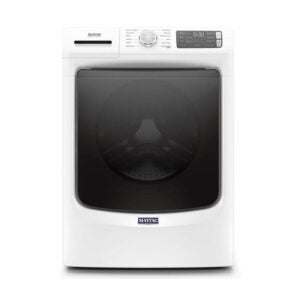
Pair the Maytag 4.8 cu. ft. Stackable Front Load Washing Machine with a stackable dryer for efficient use of space. This washer provides powerful cleaning capabilities, especially when using the heavy-duty cycle combined with the extra power function. Plus, a steam cleaning option can be combined with the extra power function or used with select cycles to lift stains.
A 16-hour fresh hold option keeps clean laundry fresh while in the drum with an internal fan and intermittent tumble. This stackable washer is made with Maytag commercial technology, including a direct drive motor and stainless steel wash basket. Overall, this unit receives high grades for its features and energy efficiency.
Smart Pick
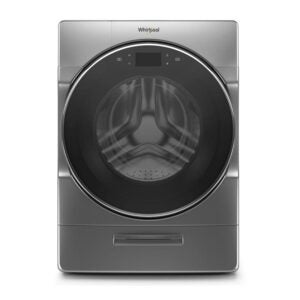
The Whirlpool 5.0 cu. ft. Front Load Washing Machine keeps you connected with wifi capability and a mobile app. Operate and check the status of your washer wherever you have your smartphone—so you don’t have to stop what you’re doing just to change the laundry.
35 unique cycle settings give you total customizable, programmable control of washing. A load-and-go automatic detergent dispersal system allows you to fill up once per 40 days of laundering. Use the tumble dry function to slowly dry your laundry while you’re away. Additional features include a steam clean cycle, sanitize cycle, and 15-minute quick wash cycle.
tinyurlis.gdv.gdv.htu.nuclck.ruulvis.netshrtco.detny.im
مقالات مشابه
- تعمیر پکیج بوتان در نمایندگی مجاز تعمیر پکیج بوتان تهران
- آیا در اسباب بازی خوب هستید؟ اینجا یک سریع امتحان جستجو
- از دست رفته عقاب بخشی جرقه تماس برای تحقیقات در Yokota
- نظرسنجی بهترین موسسه کنکور - دبیران برند ایران
- وب سایت فدرال برای سفارش آزمایش های رایگان برای COVID-19 در خانه هفته آینده راه اندازی می شود
- چگونه برای تمیز کردن لپ تاپ خود را
- شرکت صادرات و واردات کالاهای مختلف از جمله کاشی و سرامیک و ارائه دهنده خدمات ترانزیت و بارگیری دریایی و ریلی و ترخیص کالا برای کشورهای مختلف از جمله روسیه و کشورهای حوزه cis و سایر نقاط جهان - بازرگانی علی قانعی
- اشتباه شماره 1 اسباب بازی، به علاوه 7 بیشتر درس
- نبرد زمین بر سر چمن مصنوعی
- دوم دادخواست در غرب ویرجینیا و مرگ و میر بیمارستان